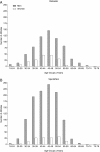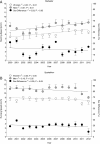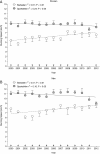Participation and performance trends in ultra-endurance running races under extreme conditions - 'Spartathlon' versus 'Badwater'
- PMID: 23848985
- PMCID: PMC3710197
- DOI: 10.1186/2046-7648-2-15
Participation and performance trends in ultra-endurance running races under extreme conditions - 'Spartathlon' versus 'Badwater'
Abstract
Background: The aim of the present study was to compare the trends in participation, performance and age of finishers in 'Badwater' and 'Spartathlon' as two of the toughest ultramarathons in the world of more than 200 km of distance.
Methods: Running speed and age of male and female finishers in Badwater and Spartathlon were analyzed from 2000 to 2012. Age of peak performance and sex difference in running speed were investigated during the studied period.
Results: The number of female and male finishes increased in Badwater and Spartathlon. Women accounted on average for 21.5% ± 6.9% in Badwater and 10.8% ± 2.3% in Spartathlon. There was a significant increase in female participation in Badwater from 18.4% to 19.1% (p < 0.01) and in Spartathlon from 11.9% to 12.5% (p = 0.02). In men, the age of finishers was higher in Badwater (46.5 ± 9.3 years) compared to Spartathlon (44.8 ± 8.2 years) (p < 0.01). The age of female finishers of both races was similar with 43.0 ± 7.5 years in Badwater and 44.5 ± 7.8 years in Spartathlon (p > 0.05). Over the years, the age of the annual five fastest men decreased in Badwater from 42.4 ± 4.2 to 39.8 ± 5.7 years (p < 0.05). For women, the age remained unchanged at 42.3 ± 3.8 years in Badwater (p > 0.05). In Spartathlon, the age was unchanged at 39.7 ± 2.4 years for men and 44.6 ± 3.2 years for women (p > 0.05). In Badwater, women and men became faster over the years. The running speed increased from 7.9 ± 0.7 to 8.7 ± 0.6 km/h (p < 0.01) in men and from 5.4 ± 1.1 to 6.6 ± 0.5 km/h (p < 0.01) in women. The sex difference in running speed remained unchanged at 19.8% ± 4.8% (p > 0.05). In Spartathlon, the running speed was stable over time at 10.8 ± 0.7 km/h for men and 8.7 ± 0.5 km/h for women (p > 0.05). The sex difference remained unchanged at 19.6% ± 2.5% (p > 0.05).
Conclusions: These results suggest that for both Badwater and Spartathlon, (a) female participation increased, (b) the fastest finishers were approximately 40 to 45 years, and (c) the sex difference was at approximately 20%. Women will not outrun men in both Badwater and Spartathlon races. Master ultramarathoners can achieve a high level of performance in ultramarathons greater than 200 km under extreme conditions.
Figures





References
LinkOut - more resources
Full Text Sources
Other Literature Sources

